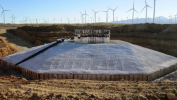Not entirely true.
The cables from the windmills, to the respective junctions, to the main trunk line come out. I've been part of some crews doing that work. Believe it or not there are wind farms that have gone through their life spans and are getting decommissioned. More now than ever actually.
The cables all come out because 1) it's in their contracts, and 2) if you ever look at an electrical schematic for a wind farm as a whole the cables aren't laid in an organized mater. It's point to point in the shortest possible path to save cable costs. If a utility ever wanted to put windmills back up on that land they'd never be able to because they'd hit cable and ruin trenchers every ten minutes. You don't do directional boring on those jobs because it takes way to long and would cost 10 times as much.
Windmill foundations you couldn't get that concrete out if you tried. It would take a fairly large bunker buster missile to even make a dent and that's not exaggeration. I worked with Zond and Vestas pretty extensively and those crews put foundations in of around 1,500 tons of concrete minus the rebar and steel column in the middle of it. Most people don't know how big the foundations are. The size of the bases around the Midwest are about 20-25 feet deep and 80-90 feet in diameter. Some are much bigger when you get into sandier subsoil.
When windmills are decommissioned the contracts say the bases have to be ground down to 24-36" below the typical grade including the bolts, and that's exactly what they do.
But cables? They all come out.
View attachment 9837


